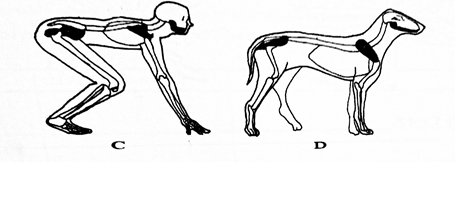Question 1
The diagrams below are illustrations of some parts of the skeletal system in humans. Study them and answer questions 1(a) to 1(c).
Study them and answer questions 1 (a) to (c).
(a) (i) Name diagrams A and B. [2 marks]
(ii) Name the parts labelled I to X. [5 marks]
(b) Name the type of joint that exists between each of the following pairs of bones.
(i) I and II:
(ii) VII and IX:
(iii) II and IV:
(iv) VI and IX: [4 marks]
(c) Name the location of each of the parts labelled I, III and VII in the human body. [3 marks]
The diagrams below are illustrations of two organisms. Study them and answer questions 1(d) to 1(g).

(d) State five observable differences between organisms C and D. [5 marks]
(e)(i) Which of the labelled organisms would run faster in the illustrated position? [1 mark]
(ii) State one reason for the answer in 1(e)(i) [1 mark]
(f) Classify organisms C and D into:
(i) Kingdom;
(ii) Phylum;
(iii) Class. [3 marks]
(g) State one reason for the answer in 1(f)(ii) [1 mark]
Observation
This question required candidates to name the bones. Majority of the candidates named the bones individually, although some could name the labelled parts. A few that lost marks here lost to the spelling of the labelled parts.
Some candidates could not classify organisms C and D into their kingdom, phylum and class.
The expected answers are:
1 (a)(i) Identification of Illustration A and B
A: (part of) appendicular skeleton and lower part of vertebral column/(part of) hind limb bones, pelvic girdle and part of vertebral column.
B: (part of) the appendicular skeleton/(part of) fore limb bones and pectoral girdle.
(ii) Parts labeled I to X
I- Pelvic girdle/pelvis/hip bone/ilium
II- Femur
III- Patella/knee cap
IV- Tibia
V- Fibula
VI - Ulna
VII - Scapula/shoulder blade
VIII - Clavicle/collar bone
IX - Humerus
X - Radius
(b) Type of Joint between
(i) I and II - Ball and Socket
(ii) VII and IX - Ball and socket
(iii) II and IV - Hinge
(iv) VI and IX - Hinge
(c) Location of parts labelled I, III and VII in a human body
I - Hip/waist
III - Knee
VII - Shoulder
(d) Observable differences between diagrams C and D
| C | D |
|---|---|
| - absence of tail | presence of tail; |
| - round head | oblong/oval head; |
| - hind limb bent forward | hind limb bent backward; |
| - separated digits | fused digits; |
| - short neck | long neck; |
| - presence of phallenges | presence of hoofs; |
| - chest/ribcage is small | Chest/ribcage is large; |
| - femur is long | femur is short; |
(e) (i) Mammal that would run faster in the position
D
(ii) Reason for answer in (e) (i)
- Streamlined head of D;
- Has hooves (with smaller surface area in contact with the ground);
- Larger chest makes it to take in more oxygen/breathe faster;
- It moves on all four legs.
(f) Classification of organisms C and D
(i) Kingdom
Animalia
(ii) Phylum
Chordata
(iii)Class
Mammalia
(g) Reason for Phylum
- Presence of backbone/vertebral column/spinal column;
- Presence of post anal tail;
- Presence of notochord;
- Hollow dorsal nerve chord;
- Presence of pharyngeal cleft.
